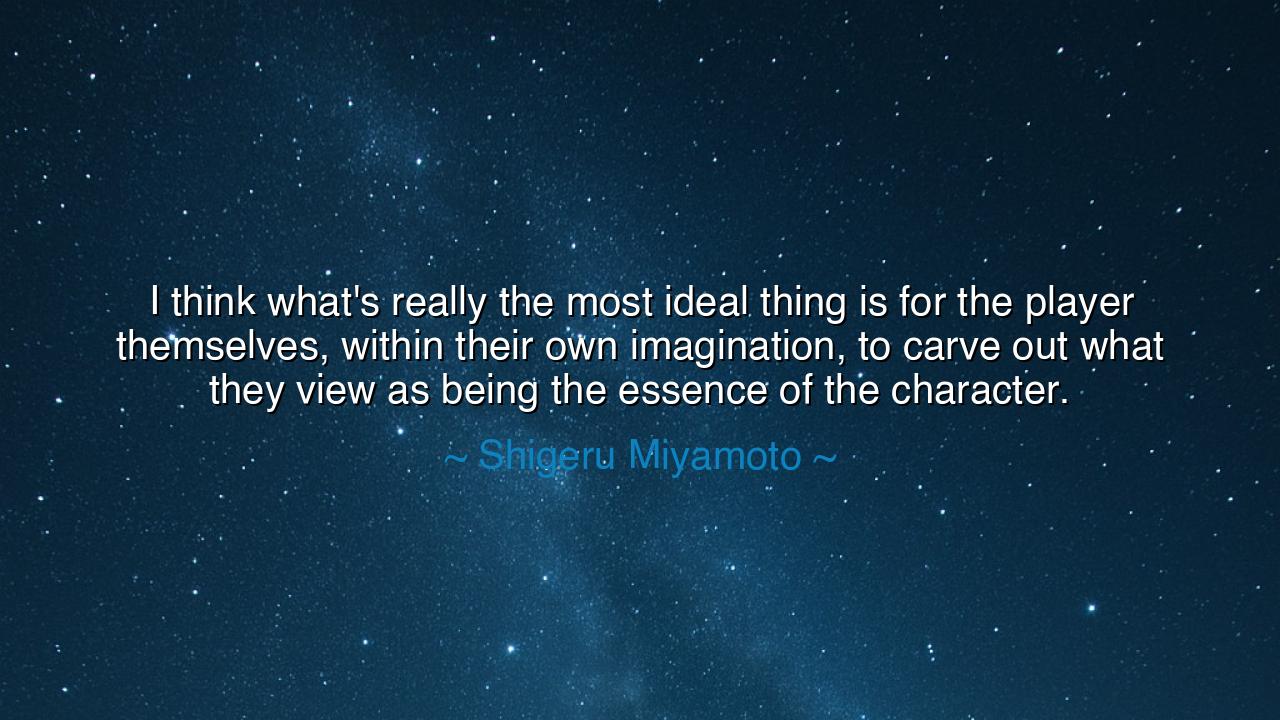
I think what's really the most ideal thing is for the player
I think what's really the most ideal thing is for the player themselves, within their own imagination, to carve out what they view as being the essence of the character.






“I think what's really the most ideal thing is for the player themselves, within their own imagination, to carve out what they view as being the essence of the character.” Thus spoke Shigeru Miyamoto, the great architect of worlds unseen — the creator of adventures that shaped generations, from the green fields of Hyrule to the galaxies beyond the stars. His words, though born in the realm of games, resound with a wisdom that transcends it: the call for every soul to become a creator, not merely a spectator. In his teaching, the imagination is not a mirror that reflects another’s vision, but a chisel in the hands of the spirit — shaping, defining, and giving life to meaning itself.
To Miyamoto, the joy of creation lies not in dictating every detail, but in inviting the player — the wanderer, the dreamer — to bring forth their own vision. The character, he says, must not be a statue carved by the artist alone, but a living figure shaped by the minds of those who encounter it. Each person, through their own imagination, discovers what is most essential — the courage, the curiosity, the humanity within the hero. In this way, every adventure becomes a dialogue between creator and participant, between the dreamer and the dream.
This truth echoes the teachings of the ancients, who knew that art is not possession, but communion. The sculptor may shape the marble, yet it is the gaze of the beholder that completes the work. The poet may write the verse, but the reader’s heart gives it music. So too does Miyamoto speak of this sacred partnership — that the truest art leaves space for the soul of another. For when the imagination is stirred, the world ceases to be something observed and becomes something lived.
Consider the example of the great playwright William Shakespeare. He gave the world kings and fools, lovers and villains, yet never told us who they truly were. Was Hamlet mad or wise? Was Macbeth damned or desperate? Shakespeare left such questions to the imagination of the audience, trusting that each soul would carve its own understanding. Thus, his art lives eternally, not because it answers all questions, but because it awakens the power to ask them. Miyamoto, in his modern craft, follows this same timeless path — building worlds not to contain us, but to free us.
In truth, his teaching reaches beyond art into the fabric of life itself. Each of us walks through existence as both player and creator, shaping the meaning of our days through the choices we make. No one can define for us the essence of our character — not teacher, nor parent, nor society. We must, within our own imagination, carve that essence ourselves. To live is to be sculptor and sculpture at once — to discover through trial, failure, and wonder what we truly are.
Yet how many wander through life content to play by another’s script? They imitate, they follow, they repeat — never realizing that the divine gift of imagination was given so that they might author their own story. Miyamoto’s wisdom reminds us that the world offers not answers, but instruments. What you build, how you play, how you live — these are the strokes of your personal creation. You, too, are a player, and the game is your life.
The lesson, then, is both humbling and empowering: do not wait for others to define you. Take up the chisel of imagination and shape your own essence. Whether in art, in work, or in love, enter each space not as a consumer of meaning, but as a maker of it. Look upon the world and ask, “What can I create within this?” For every human being is born with the same sacred capacity — to see differently, to feel deeply, to carve beauty out of the raw stone of existence.
So, my friend, remember the teaching of Shigeru Miyamoto: the truest worlds are those built by the heart. Do your part in shaping them. Dream bravely, imagine fully, and live as the artist of your own spirit. For when you, within your own imagination, carve the essence of your character, you become not only the hero of your own story — you become the creator of your own universe.






AAdministratorAdministrator
Welcome, honored guests. Please leave a comment, we will respond soon